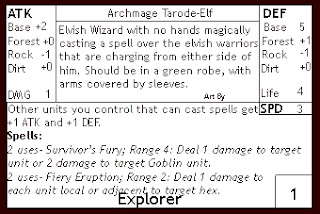 The last post on this blog is dated August of 2008. Following that post, almost no work was done on the game, and we lost interest and moved on. OR SO WE THOUGHT! While cleaning out my file system on my computer this week, I stumbled across our old design files. I texted Gavin and he agreed that the game deserved to be finished. We were so close when we quit to done that it seems almost criminal not to finish.
The last post on this blog is dated August of 2008. Following that post, almost no work was done on the game, and we lost interest and moved on. OR SO WE THOUGHT! While cleaning out my file system on my computer this week, I stumbled across our old design files. I texted Gavin and he agreed that the game deserved to be finished. We were so close when we quit to done that it seems almost criminal not to finish.However, things have changed. It's probably going to almost entirely me (John) doing the finishing touches, though maybe I can rope Gavin or Vincent in as well. We're a bit older now, having gone off to college, and I've played a good deal more games in between the start of the this design and now. As such, I have a couple large redesigns I'd like to make. This post is intended primarily to go over some of the changes that my redesign is going to bring to Ruin.
Theme:
When we started Ruin, we had designed an elaborate fantasy world, incorporating elements from some of our favorite fiction. Looking back on it, most of our writing and storyline was amateurish and lackluster. As such, I've decided to scrap the fantasy theme for something that has a better connection to the game's central theme of exploration and ancient ruins. Rather than fights between Elves, Goblins, etc., Ruin moving forward will consist of cards representing ancient cultures and their respective mythologies. The cultures I've chosen to focus on for the first batch of Ruin cards (read: for playtesting) are the following:
- Heroic Age Greece / Greek Mythology
- The Maya / Mayan Folklore
- Ancient Egypt
- Norse Mythology / Nordic Folklore
- Shang Dynasty China/ Chinese Mythology
For reference, I'm making the following moves thematically:
Kaalik -> Eygptian
Kel'Quiroth -> Norse
Goblin -> Mayan
Elves -> Greece
Humans (General) -> China
Graphic Design:
Since going off to college, I've developed a small taste for design (I did the Parthenon graphic above in Illustrator). I'm not great, but I think applying some of my new skills to a redesign of the cardface and the terrain tiles will really improve game quality.
Other graphical changes include an image overlay on Assistant and Explorer cards to signify the culture that they come from.
Gameplay:
In addition to removing a number of mechanics that were complicated and added little to gameplay, such as Goblin Hate, Attachment, and the rules regarding numerical advantage, the game board is going to be made smaller by reducing the number of hexes on each terrain card. This will reduce the number of turns it takes for combat/meaningful interaction to begin.
In addition, terrain will be printed onto cardboard tiles, reducing the setup time to build the map.
More changes are coming, but these are the most major ones, so I thought I'd cover them first. I can't leave you without a little something something, so without further ado:
Oh...that's Archmage Tarode. That's not new at all. Click the spoiler below to reveal the new, re-themed Archmage, along with a preview of the new cardface!
The card redesign isn't in its final form at all, as I just cranked out the graphics really fast in Adobe Illustrator. (The culture background I took my time on, so that isn't likely to change) I do, however, think the redesign offers a significant improvement in readability and functionality. Note that it doesn't have a damage icon. I was thinking about having all attacks deal 1 damage unless otherwise stated on the card. (only 13/68 Assistants deal more than 1 damage, and only 5/29 explorers deal more than 1)
Anyway, that's all for now. Next time, I'll show off a few more redesigns and the backgrounds for the other 4 cultures (and the cultureless background).
-John



